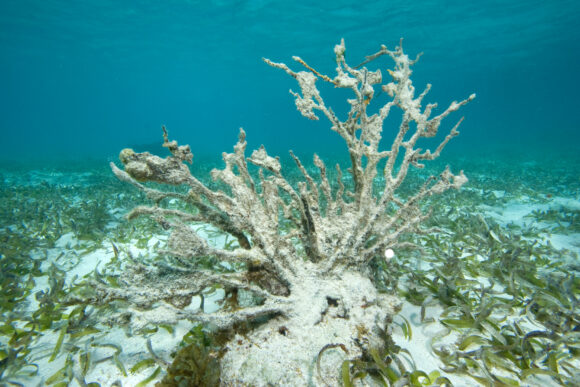Extreme ocean heat has eradicated two key coral species in Florida from a 350-mile-long reef that protects the state’s coastal cities from storms and provides habitat for fisheries, scientists have found.
A record marine heat wave in 2023 killed so many Acropora corals that two species are now “functionally extinct,” meaning that so few remain that they’re no longer effectively adding to the coral structure, called Florida’s Coral Reef, according to a study published Thursday in the journal Science.
Other reef-building corals survived the 2023 Florida heat wave but the two Acropora species, commonly known as elkhorn and staghorn corals, were major contributors to reef expansion and their extirpation means a long-term decline in habitat, according to scientists. That in turn will affect marine biodiversity that supports commercially valuable fisheries.
The reef wraps around the state’s southeastern and southern coasts, which are exposed to increasingly frequent and intense hurricanes and tropical storms as the ocean warms. The reef dissipates wave energy from approaching storms, mitigating costly coastal erosion and other damage. It’s a living organism and the demise of the Acropora species will hamper its ability to regenerate from heat waves.
“These heavily urbanized coastlines are protected by coral reefs and the loss of the Acropora and their contributions to those reefs will have a number of cascading effects ecologically and economically,” said Ross Cunning, a lead author of the paper and a research biologist at the Shedd Aquarium in Chicago.
Scientists had declared a third species on the reef, Pillar coral, functionally extinct in 2020. More than 40 reef-building corals remain but they have also been affected by marine heat waves and disease.
Globally, coral reefs provide habitat for 25% of marine life and underpin an estimated $2.7 trillion a year of goods and services.
Florida’s corals had been on the decline for decades due to pollution, disease and overfishing. But a succession of eight marine heat waves since 1987 severely weakened their resilience. Then the ninth hit in 2023, exposing the reef to temperatures greater than 88F (31C) for an average of 40 days. That triggered what the scientists call acute heat stress, which killed corals in a matter of days. In some places, ocean surface temperatures reached a record 101F (38.3C).
“This study is showing how one single environmental disturbance, the heat wave of 2023, was so severe that it was able to surpass the limits for survival for these species,” said Cunning, noting such high ocean temperatures are likely to become more common worldwide as climate impacts accelerate.
Researchers from Shedd, the US National Oceanic and Atmospheric Administration, the US Geological Survey and other institutions surveyed more than 52,000 elkhorn and staghorn colonies at 391 sites. They found nearly all the corals on the western section of the reef died, while mortality was about 38% in cooler waters in the southeast.
In recent years, a significant coral restoration effort has been underway on the reef, and Cunning said scientists are now developing new techniques to help corals survive rapidly rising ocean temperatures. This past summer, scientists planted elkhorn corals off Miami that had been crossbred with a variety accustomed to warmer waters in Honduras. Researchers are also experimenting with inoculating corals with more heat-resistant strains of algae that live inside them and supply their nutrition and color.
But Cunning said such efforts will be futile unless fossil fuel emissions are slashed. “No amount of research and intervention and restoration is going to be able to secure a future for reefs if climate change is allowed to continue at these rates,” he said.
Photo: Dead coral in the Florida Keys National Marine Sanctuary (AdobeStock)
Topics Florida
Was this article valuable?
Here are more articles you may enjoy.



 Product Liability Verdicts Are on the Rise but There Are Ways to Avoid Them
Product Liability Verdicts Are on the Rise but There Are Ways to Avoid Them  Airline Pilots Hide Mental Health Struggles to Keep Flying
Airline Pilots Hide Mental Health Struggles to Keep Flying  In Alabama, Shot Employee Gets No Workers’ Comp and No Employer’s Liability
In Alabama, Shot Employee Gets No Workers’ Comp and No Employer’s Liability  Litigation Finance Hits a Wall After Bets on Huge Gains Falter
Litigation Finance Hits a Wall After Bets on Huge Gains Falter 

